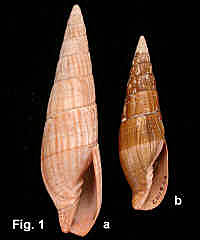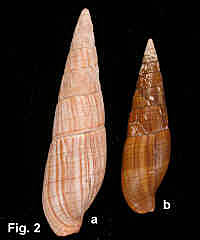|
|
|
||||||||
|
|
Mitra glabra Swainson, 1821 Description: Shell solid, whorls slightly convex, aperture short, slightly more than one-third length of shell. Sculptured with minutely punctate shallow spiral grooves, varying from very faint in some specimens to strong in others; up to 15 on the penultimate whorl and 25 on the body whorl. Columella with 4-5 folds. Colour fawn, with some of the spiral grooves orange-brown, giving thin, widely spaced, spiral lines, and usually with brown axial streaks. Aperture and columella orange-brown or greyish white. Shell covered with a thick, dark brown periostracum when alive. Size: Up to 103 mm in length. Distribution: Endemic to Australia; Port Macquarie, NSW, to Fremantle, WA, including Tasmania. Habitat: In sand on exposed rocky shores, usually under stones, low tide to 100 metres. Moderately common. Synonyms: Vicimitra exposita Iredale, 1936 has almost straight sided whorls, but it falls within the range of variation of M. glabra. Remarks: This species lives burrowed in the sand during the day, coming out to feed at night on the sipunculid worm Themiste cymodoceae (Ludbrook, 1984). Figs. 1a, 2a: Long Reef, Collaroy, NSW (DLB3421) Figs. 1b, 2b: Trawled off Westerport, Victoria (C.111922)
|
||||||||

